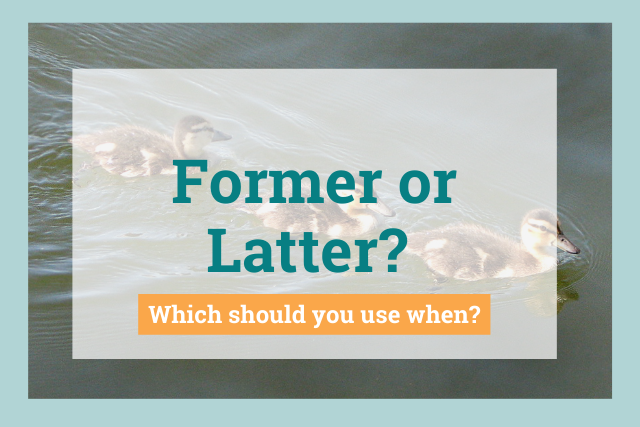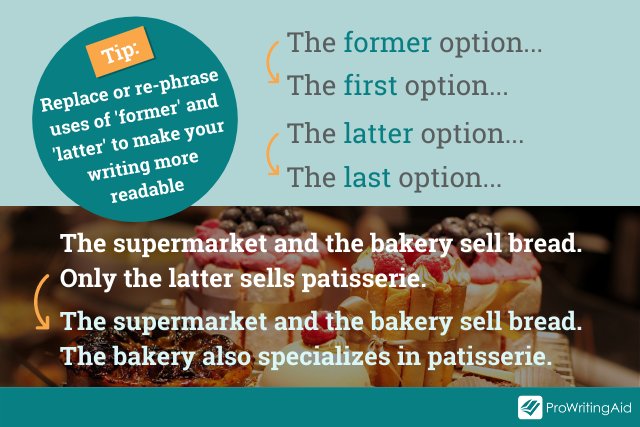
What Type of Words are Former and Latter?
Former and latter are referential words, used as adjectives to describe a noun that comes before them. That means they refer to something else—a person, place, or thing mentioned before.
To distinguish between latter and former, you need to understand what the reference is. The reference is usually a comparison of two items in the preceding sentence or paragraph.
Here’s an example of a sentence as a base for using former and latter:
Steve’s tasks for the day were leading the weekly team meeting and exercising the dog on a long walk.
The word former would refer to leading the team meeting and latter would refer to the dog adventure. We’ll get to how former and latter work in sentences in a minute.
Former refers to the first item in the sequence and latter refers to the last item in the sequence. They are easy to remember.
- Former—means first (in a preceding sequence)
- Latter—means last (in a preceding sequence)

When to Use Former and Latter
Because former and latter refer to a preceding sentence, it’s unusual to find them in everyday speech, a casual blog article, or a social media post.
A listener in conversation may have a hard time remembering the order of items they just heard. A blog reader might think your wording sounds stilted. And someone scrolling through social media posts may not have enough information to understand the reference.
But, former and latter are used in formal and technical writing to help readers understand the focus of the current sentence.
Use of both former and latter has declined in usage in both British and American English as writers increasingly discover that direct reference creates clarity in books, journals, and magazines.
In order to use the words former and latter correctly, you'll need to understand their conventional uses and limitations. Let's take a look.
How to Use Former
Former is an adjective that uses three rationales. Each use refers to something previous.
Use #1: Using Former After a Sequence
In the first type, former refers to the first of two items mentioned in a sequence.
Here are some examples of using former following a sequence:
Semantic SEO outperforms SEO to connect with customers. The former focuses on real-world objects (entities) made up of people, places, and things—like ideas and concepts.
Homes in cold weather locations may have two water shut-off valves: the main shut-off valve and the exterior shut-off valve. The former controls water flow for the entire structure, inside and outside.
The agenda for Friday’s meeting lists new tax collection for Australia and Chile and post-pandemic shipping logistics. The former is in place for all subscriptions starting July 1.

PRO TIP: Do not use former with a sequence of three or more ideas. In that case, rephrase the statement for clarity.
Use #2: Using Former to Refer to Something Past
Former also refers to something that happened in a previous place or time.
Examples of using former to refer to previous occurrences:
The conference convened for two days. During the former, an argument broke out over inclusion policies.
The former routing avoided toll highways.
The new apartment complex is on the former landfill site.
Use #3: Former to Show a Previous Condition
Finally, former can indicate a previous position or state that no longer exists.
Check out these examples of using former to show a previous condition:
Lisa’s former husband showed up at the engagement party unannounced.
Erroll Farmingham, the former mayor, addressed the city council.
Included in this use is a common idiomatic expression: former self.
- After she lost her children in the automobile accident, Jennifer was a shadow of her former self.
Throughout all of these examples, the basic guideline for using former is to refer to something that occurred before. It can be the first in a sequence, a previous occurrence, or an earlier position or state.
How to Use Latter
Latter is an adjective with two common uses. You’ll refer to a person, place, or thing that comes at the end.
Use #1: The Latter Item in a Sequence
Use latter to refer to the last of two items in a sequence.
Here are some examples of using latter to refer to the last item in a sequence.
Tenant onboarding includes a credit check and reference checks. The latter will take more time.
Once you’ve been accepted into a college, you’ll find you need determination and hard work to make it through the next few years to graduation. The latter is more important to your success.
Tree roots can cause cracks in sidewalks and foundations. The latter presents serious structural concerns for future homeowners.

Because latter refers to the last item in a sequence, you can use it in lists longer than two items.
Example of latter with a list longer than two items:
- Boil the baby artichokes with spices, lemon juice, and fresh cardamom leaves. You can substitute coriander seeds for the latter.
Use #2: Latter as a Synonym for "Later" or "Near the End"
Examples of latter as a synonym:
During the latter part of the 19th century, bars replaced coffee houses as places for convivial meeting.
The latter semesters of the master’s degree program focus on reading for the comprehensive oral examinations.
During the latter hours of turkey roasting, use the time to prepare side dishes like salads and fresh vegetables.
Remember that latter refers to the last or final person, place, or thing.
Ways to Modernize Your Reference Language
When you use former or latter, you require your reader to stop reading—never a good thing—and go back to reread the preceding sentence.
You can modernize your language with explicit references. Clarity helps your reader understand your point immediately.
Here’s an example with former:
Old version:
- Bellingcat and Soldier of Fortune both report on international terrorism. The former presents well-researched, in-depth coverage.
New version:
- Bellingcat and Soldier of Fortune both report on international terrorism. The Bellingcat use of public data and citizen journalism provides well-researched, in-depth coverage.

Here’s an example with latter:
Old version:
- Jess and Stuart both arrived late to the meeting, with the latter sauntering in like he owned the room.
New version:
- Jess and Stuart both arrived late to the meeting. Stuart sauntered in like he owned the room.
And here's how to modernize your reference language when you use both latter and former:
Old version:
- While neuroscientists struggle to understand how there can be such a thing as a first-person reality, quantum physicists have to grapple with the mystery of how there can be anything but a first-person reality. The former posit a mystery and the latter a reality, but they are saying the same thing.
Just don’t do it. You make your reader work too hard to understand your message. First, your readability score will be high, and, second, your reader needs to go back to reread the entire previous sentence.
New version:
- While neuroscientists struggle to understand how there can be such a thing as a first-person reality, quantum physicists have to grapple with the mystery of how there can be anything but a first-person reality. Neuroscientists contend we need to observe reality, and quantum physicists say they require monitoring. They both lead back to observation.
Especially when you are presenting complex concepts, clarity works in your favor. You make it easier for your reader to understand the logic of your argument.
In business writing, coming across as a person who is easy to understand and relatable is an advantage.

You can change:
- Which of these two options do you like best, the former or the latter?
to
- Choose one of these two items.
or
- Which of these two would you like, the first or the second?
Rephrasing your sentence to eliminate using former or latter and instead clearly stating the noun enhances reader understanding. You improve readability to help your reader comprehend your exact meaning. And your language won’t sound formal and outdated.
Improve Your Readability
Using these terms correctly means you understand the grammar rules. But good grammar isn’t the only test for how your reader comprehends your text. Your job as a writer is to connect with readers.
If your text is difficult to understand, your writing will repel rather than attract readers.
Readability is usually described as a grade-reading level. But readability also indicates how well your writing connects with readers.
Formal, stilted language, even though it is grammatically correct, can make what you say difficult to read.
Improve readability by using the simplest words. For example, instead of using former, use first. There will be no question in your reader’s mind about your reference.
Check out this excerpt on readability from our recent session, The Five Principles of Creating Clarity. You'll see how ProWritingAid's editing software can help you spot places where you may need to make your document easier to read.
Or, watch the whole video to find out how to make your writing as clear as possible for your readers.
Writing isn’t about showing how smart you are, it’s about getting people to read what you write, understand what you say, and follow your logic.
Use ProWritingAid's Style and Readability reports to identify places where you can simplify text for better understanding. Your readers will appreciate your direct, clear approach.
If you want to remind yourself to avoid using the words latter and former in your writing, you can set up a custom rule in your own personal ProWritingAid Style Guide.
Now that you understand how former and latter refer to people, places, or things—including ideas and concepts—start writing text that uses clear references. You’ll increase reader response to your business correspondence, articles, white papers, and books.


